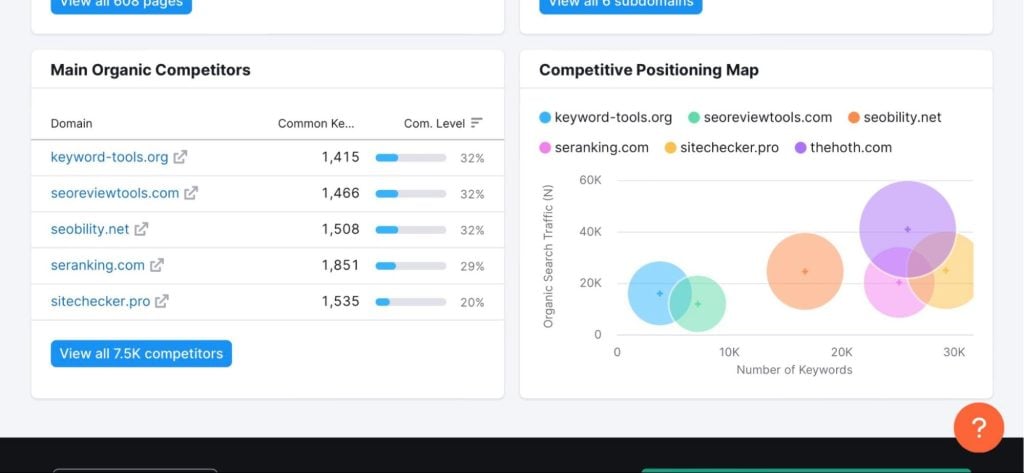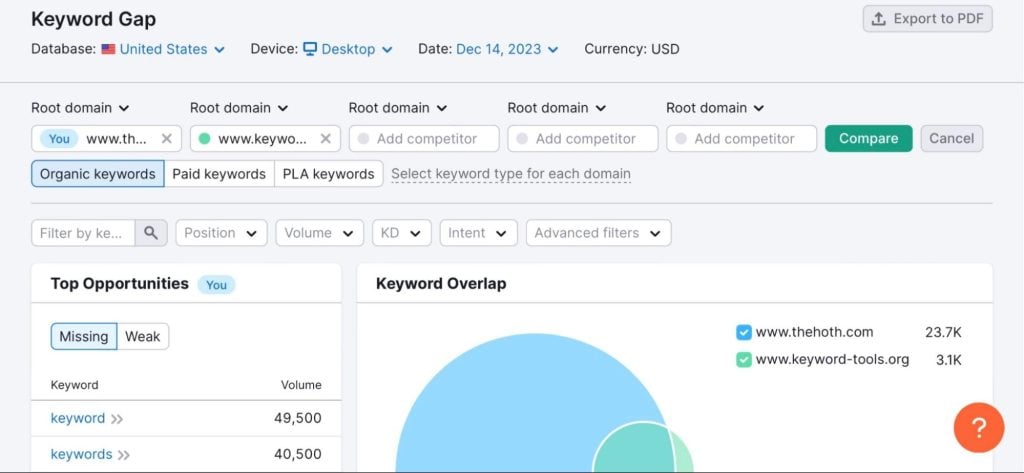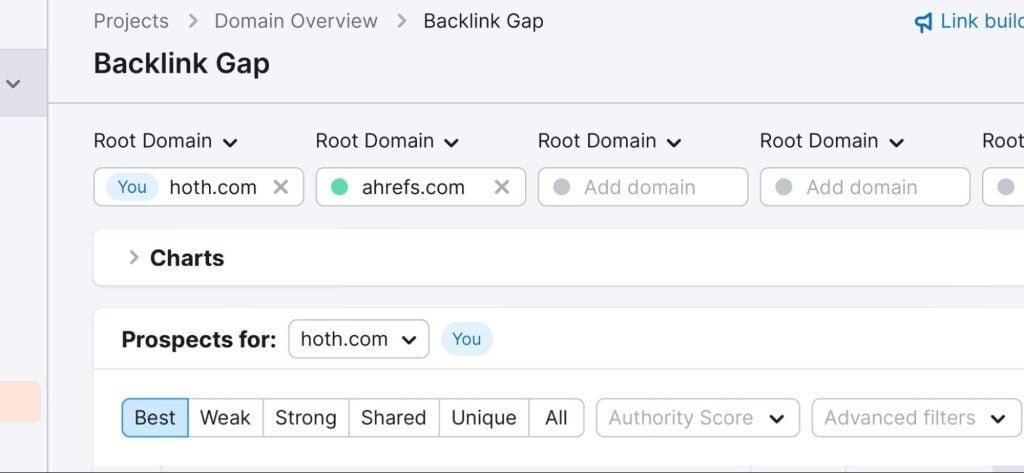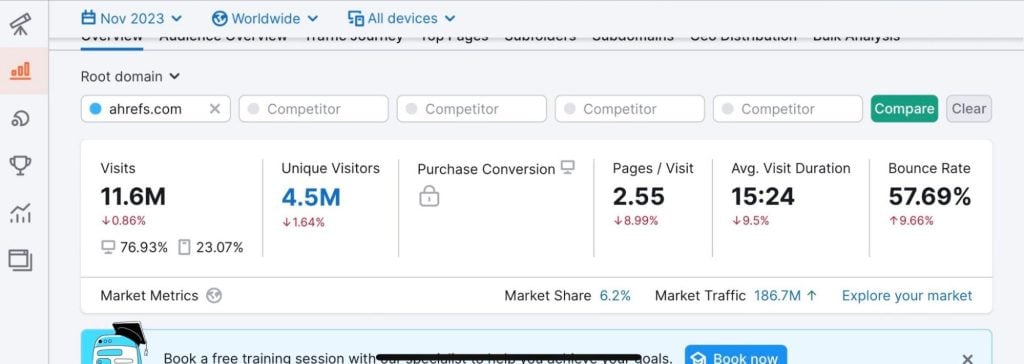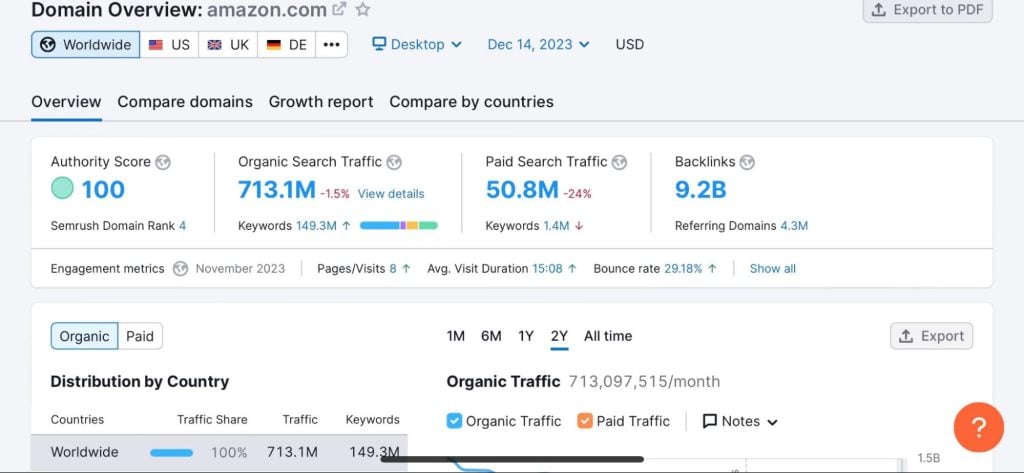Is there a competing website you can’t seem to outrank on the SERPs (search engine results pages)?
If so, you need to perform an SEO competitor analysis to understand why they always seem to be on top.
Otherwise, you’ll be shooting in the dark with your SEO efforts, making it highly unlikely that you’ll ever crack the code.
Even if you somehow manage to outrank them through random tactics, you won’t know why – making it incredibly difficult to maintain the edge.
With an in-depth SEO competitor analysis, you’ll learn precisely why other sites are outranking you, such as a considerable gap in the number of backlinks you have compared to sites ranking in the top 5.
When it comes to analyzing your SEO competitors, there’s no better platform to use than Semrush.
Why is that?
It’s because Semrush provides a whole host of tools perfect for sizing up the competition.
These tools allow you to do the following:
- Identify top competitors in your field
- Analyze competitors’ backlink profiles and authority scores
- View keywords competitors are ranking for that you aren’t
- Discover lost keyword rankings
- Learn your competitor’s strengths and weaknesses
- Compare your SEO performance to other sites
As you can see, you can use Semrush to uncover invaluable SEO insights that’ll supercharge your campaigns.
We’ve only scratched the surface so far, so stay tuned to learn how to perform a complete SEO competitor analysis with Semrush.
What’s a SEO Competitor Analysis, and Why Does it Matter?
The search engine landscape is fiercely competitive, with websites from every industry and niche duking it out to rank as high as possible on the SERPs for their most important keywords.
Google’s ranking algorithm is kept under lock and key, so SEOs are constantly experimenting with new ways to boost their online visibility and position rankings.
These tactics have varying degrees of effectiveness, and while there are certain SEO best practices that most sites follow, SERP rankings can be mysterious at times.
That’s why taking a peek behind the scenes with a competitor analysis is so helpful.
For example, if a website is beating you in the rankings for your most important keyword, there could be a million reasons why.
They could have higher quality content, better keyword optimization, more backlinks, tighter technical SEO factors (like faster loading speed), and the list goes on and on.
Only when you sit down to do a competitor analysis will you finally learn why another site is getting the best of you on the SERPs.
Once you know why you’re getting left in the dust, you’ll be able to make the necessary modifications to your site to start closing the gap and eventually outrank them.
Knowledge is power, and Semrush will equip you with the tools you need to learn your competitors’ secrets.
If you’re ready to take your SEO game to the next level, don’t wait to try out Semrush Pro today.
How to Use Semrushto Conduct an SEO Competitor Analysis Step-by-Step
Semrush has an entire suite of tools dedicated to competitive research on its SEO dashboard, which includes the following:
- Domain Overview
- Traffic Analytics
- Organic Research
- Keyword Gap
- Backlink Gap
Each tool contains ways to garner valuable insights from competitors, so let’s dive in for a closer look.
Step #1: Square up competitors with the Organic Research tool
First things first: You need to learn who your top competitors are, and Semrush’s Organic Research tool is the easiest way to find them.
The tool is extremely easy to use, as you just need to enter your domain, select your country, and hit the Search button.
From there, you’ll be greeted with a ton of widgets breaking down things like your top keywords, position changes, and keyword trends.
However, what we’re interested in is the Main Organic Competitors widget near the bottom of the page. Here, you’ll find a list of your top 5 organic competitors. You can also view the entire list of your competitors (ours contains 7.5k sites, so we’ll stick with the top 5).
Step #2: Use the Keyword Gap tool to peek at their keywords
Next, the true analysis begins. The Keyword Gap tool will let you know about all the keywords your competitors are ranking for that you aren’t.
This is super helpful for two reasons: A) you get to uncover valuable keyword opportunities you wouldn’t have known about otherwise, and B) you’ll be able to tell if competitors are outranking you due to their use of keywords.
You can enter up to four competitors to compare keyword profiles.
The Missing filter will let you know which keywords they rank for you, but you don’t, while the Weak filter lets you know which keywords they’re better optimized for than you.
Step #3: Use the Backlink Gap tool to size up their link profile
Backlinks are a huge ranking factor for Google Search, so if a competitor has stronger backlinks than you, they’ll likely outrank you.
To find out if links are the culprit, navigate to SEMrush’s Backlink Gap tool from the SEO Dashboard.
It works exactly like the Keyword Gap tool, where you can enter up to 4 competitors to compare link profiles.
This tool is amazing for uncovering valuable backlink opportunities from your competitors, such as syndication networks and sites that accept guest posts.
Step #4: Analyze their traffic and metrics
Lastly, don’t forget to take a look at your competitor’s traffic and site metrics using the Traffic Analytics and Domain Overview tools.
The Traffic Analytics tool provides metrics like bounce rate, dwell time, unique visitors, device trends, and top traffic channels.
These will help you better understand your competitor’s strengths and weaknesses, which you can use to your advantage.
The Domain Overview tool is where you’ll find competitors’ authority scores (which represent how likely they are to appear in the SERPs), total backlinks, and organic search traffic. You can also view their traffic distribution by country to understand where most of their traffic comes from.
Using Semrush to Crush the Competition
Performing an SEO competitor analysis is made simple with Semrush, and the platform contains other tools to help bolster your SEO strategy.
Once you understand why your competitors are beating you on the SERPs, you’ll know the exact steps you need to take to leave them in the dust (instead of the other way around).
If you’re ready to take your SEO game to the next level, don’t wait to try out Semrush Pro today.
The post I See What You Did There: Analyzing Competitors with Semrush appeared first on The HOTH.
Go to Source
Author: Steven Gill


